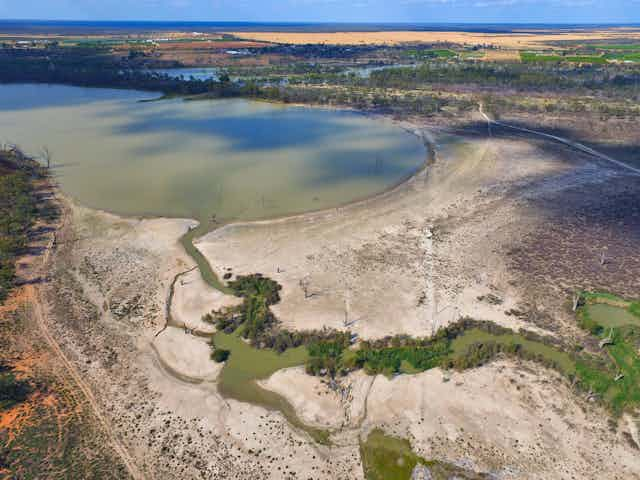Tempers have flared once again over the long-term plan to return water to the Murray-Darling River and improve its health.
The Murray-Darling Basin Authority has released its report into the northern basin (in Queensland and New South Wales). The report finds that the plan, agreed in 2012, has already affected communities. It recommends that less water be returned to the river.
The plan aims to recover 2,750 gigalitres of water from human uses for the environment, but also allows for an extra 450GL to be recovered.
Federal Agriculture Minister Barnaby Joyce has signalled that returning the extra 450GL would be extremely difficult – which has outraged South Australian politicians at state and federal level. In response, Prime Minister Malcolm Turnbull has promised extra monitoring.
While it may seem like a political bunfight, the current argument sheds light on serious flaws in the management of the river.
Liquid gold

The Murray-Darling Basin Plan originates in national water legislation developed as a response to the Millennium Drought. Since the plan was passed in 2012, rains have given breathing space for those seeking to massage the detail around rebalancing Australia’s most famous river system.
The premise of the plan and the related Water Act is shifting water away from irrigation to the river to improve long-term sustainability. Leading up to and during the Millennium Drought, ecosystem health declined.
Too much water was being taken from the river, and it seemed the states were too weak to deal with the politics of sharing water allowances.
However, Joyce’s recent comments show that federal governments are equally susceptible to backsliding on commitments to securing water for the environment.
Flaws in the plan
The plan has two main flaws.
First, the states and federal government are relying on a single planning instrument to miraculously optimise water-sharing for social, economic and environmental outcomes.
Second, the only mechanism for achieving these outcomes is by adjusting the volume of water allocated to the environment.
Various interests have exploited both of these weaknesses since the plan came into force.
First, the requirement to blend multiple policy objectives into a single plan has provided an opportunity for disaffected parties to claim all manner of fallout. This has led to governments opting for high-cost reallocation mechanisms, such as providing infrastructure to farms in return for water for the environment.
Simply buying entitlements from willing sellers would have been much more cost-effective and likely better in the long run. This remains the case. But buying back is now off the table, at least while the next round of expensive infrastructure-for-water swaps occurs.
Second, focusing solely on the volume of water returned to the river is now being exploited by those who know that the environmental needs of riverine systems are more complex than simply “add more water”. Complexity means opportunity for some, and there are two groups at play here.
One is the irrigation enthusiasts reluctant to transfer their water rights. In part, this is because they know if they hold out they can secure more benefits through subsidised on-farm infrastructure that can be capitalised into private assets. These forces are obviously more pronounced in the upstream states where irrigation is most developed – NSW and Victoria.
The second group are environmental groups with particular agendas for which they have struggled to gain support.
Turning wine into water
Collectively, these groups have been active in persuading upstream states and some at the federal level that there are alternatives to simply taking water from irrigators and returning it to the environment. These alternatives have become known as “works and measures”.
In simple terms, some infrastructure can be used to mimic environmental processes but with less water. For instance, a series of water regulators could be constructed on a riverside wetland to mimic natural flood events.
The proponents of works and measures are primarily upstream and have sought to count these interventions as equivalent to water returned to the river – meaning they count towards state targets. Similarly, there are efforts to convert programs that reduce invasive species, such as carp, into an equivalent volume of water.
In practice, the challenge of converting these programs into water is scientifically problematic.
While the Water Act and the basin plan were always flawed because of their heavy focus on water volumes, the prospect of adding alternatives has simply created opportunities for more blurry metrics.
There is also a real prospect that these measures are simply not equivalent. As an ecologist explained to me privately: “It’s like saying the environment is thirsty and offering a hamburger.”
The hamburger may be welcome for some, but ultimately it won’t do the same as a drink of water. We need both water and non-water measures and it would be foolish to think the politically expedient hamburger is a perfect substitute for the politically sensitive water, as others have noted.
The South Australian government has been keen to prevent backsliding by upstream states through these types of deals. Ideally, this would be out of concern for the status of the river system, but history shows that states, including South Australia, are equally keen to use the rivers for their own consumptive ambitions.
Nonetheless, the South Australian government does have a point, even if it has been expressed recently with zeal.
The lesson, of course, is that federal governments using the plan have found shifting water away from irrigation at least as difficult and costly as it is for the states.

